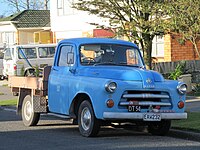| This article needs additional citations for verification. Please help improve this article by adding citations to reliable sources. Unsourced material may be challenged and removed. Find sources: "Dodge C series" – news · newspapers · books · scholar · JSTOR (April 2015) (Learn how and when to remove this message) |
| Dodge C series | |
|---|---|
 1957 C-100 Sweptside 1957 C-100 Sweptside | |
| Overview | |
| Manufacturer | Chrysler Corporation |
| Production | 1954-1960 |
| Assembly | Warren, Michigan, United States Los Angeles, California, United States (until 1955) |
| Body and chassis | |
| Class | Full-size pickup truck |
| Body style | 2-door pickup truck |
| Layout | FR layout |
| Powertrain | |
| Engine | 230 cu in (3.8 L) I6 315 cu in (5.2 L) V8 318 cu in (5.2 L) V8 331 cu in (5.4 L) V8 |
| Transmission | 3-speed automatic 2-speed PowerFlite automatic |
| Dimensions | |
| Wheelbase | 108 in (2,743 mm) 116 in (2,946 mm) |
| Chronology | |
| Predecessor | Dodge B series |
| Successor | Dodge D series |
The C series is a line of pickup trucks sold by Dodge from 1954 until 1960. It replaced the Dodge B series of trucks and was eventually supplanted by the Dodge D series, introduced in 1961. Unlike the B series, which were closely related to Dodge's prewar trucks, the C series was a complete redesign. Dodge continued the "pilot house" tradition of high-visibility cabs with a wrap-around windshield introduced in 1955. A two-speed "PowerFlite" automatic transmission was newly available that year. The Dodge Town Panel and Town Wagon also used the new design.
History
Chrysler called the Hemi-powered Dodge trucks "Power Giant" in 1957, and introduced power steering and brakes, a three-speed automatic, and a 12-volt electrical system. From 1957 to 1959, Dodge offered the Sweptside pickup, a rival to the Chevrolet Cameo Carrier, but it never became a bestseller. A flat-sided (and thus wider) "Sweptline" cargo box came in 1959. The company also adopted the standard pickup truck numbering scheme, also used by Ford and GM at that time. Thus, the ½ ton Dodge was now called the D100. The traditional separate-fender body "Utiline" version remained available, with a GVWR of up to 9,000 lb (4,100 kg) on 1-ton models.
After an agreement between Dodge and Studebaker, the C-Series' pickup bed also saw use in the Studebaker Champ pickup truck range.
Four-wheel-drive W-Series Power Wagons
Starting in the 1957 model year, factory four-wheel-drive versions of the Dodge C series trucks were produced and sold as the W-100, W-200, W-300, and W-500, alongside the older WDX/WM-300 "Military Style" Power Wagon. The latter had the "Power Wagon" badge on the fender. The heavy-duty four-wheel-drive W-300 and W-500 trucks were marketed as "Power Giants".
Engines
- 1957-1960; 230 cu in (3.8 L) Flathead I6, 120 hp (89 kW)
- 1959; 331 cu in (5.4 L) FirePower V8, 172 hp (128 kW)
- 1957-1959; 315 cu in (5.2 L) Red Ram V8, 204 hp (152 kW)
- 1959; 318 cu in (5.2 L) A-type V8, 200 hp (149 kW)
Medium-duty/heavy-duty C series
Main article: Dodge LCF seriesSince it still used the older cab design, the C series name was continued for Dodge's line of medium- and heavy-duty trucks (better known as the LCF series) through the 1975 model year, long after most of Dodge's other trucks had moved to the newer D series designation.
Four Wheel Drive also utilized the C series cabs for many of its medium- and heavy-duty trucks. Because Chrysler needed plant capacity for its newer light-duty truck models, manufacture of these later C series cabs — for both Dodge and FWD — was outsourced to Checker in Kalamazoo, MI, beginning in 1962.
References
- VIN classification
- "1957-1959 Dodge D100 Sweptside Pickup". HowStuffWorks. Archived from the original on 11 September 2011. Retrieved 28 April 2015.
- Niedermeyer, Paul (29 March 2018). "Cohort Outtake: 1963 Studebaker Champ – The Most Ill-Fitting Bed Ever". Curbside Classic.
- Foster, Pat. "A look at Studebaker's last trucks, 1960-'64". Hemmings. Retrieved 4 October 2023.
- Dixon, Russ. "Cobbled Carrier: 1964 Studebaker Champ". Barn Finds. Retrieved 4 October 2023.
- ^ Ackerson, Robert C. Standard Catalog of 4 X 4's: A Comprehensive Guide to Four-wheel Drive Vehicles Including Trucks, Vans and Sports Sedans and Sport Utility Vehicles, 1945-1993. United States: Krause Publications, 1993.
- Petroleum Week. United States: McGraw-Hill Publishing Company, Incorporated, 1958. advertisement: "De Soto and Fargo four-wheel drive models combine all the features of a conventional two-wheel-drive. Available in Body styles, a chassis-cab , chassis-cowl, or the famous military-type Power-Wagon ( W-300M ) are now available ."
- "Checker and the Dodge C-series Truck Cab". Internet Checker Taxicab Archive (ICTA). 24 February 2017. Archived from the original on 2021-04-16.
External links
- Pickup Trucks.com
- 1957-1959 Dodge D100 sweptside pickup Archived 2011-09-11 at the Wayback Machine
| Dodge | |||||||||||||||||||||||||||||||
|---|---|---|---|---|---|---|---|---|---|---|---|---|---|---|---|---|---|---|---|---|---|---|---|---|---|---|---|---|---|---|---|
| Established in 1900, a division of Chrysler since 1928 | |||||||||||||||||||||||||||||||
| Current models |
| ||||||||||||||||||||||||||||||
| Former models (by date of introduction) |
| ||||||||||||||||||||||||||||||
| Related topics | |||||||||||||||||||||||||||||||
|
Rebadged models, mostly from Japanese, Korean or Chinese manufacturers – Rebadged Chrysler/Plymouth models for external markets | |||||||||||||||||||||||||||||||


